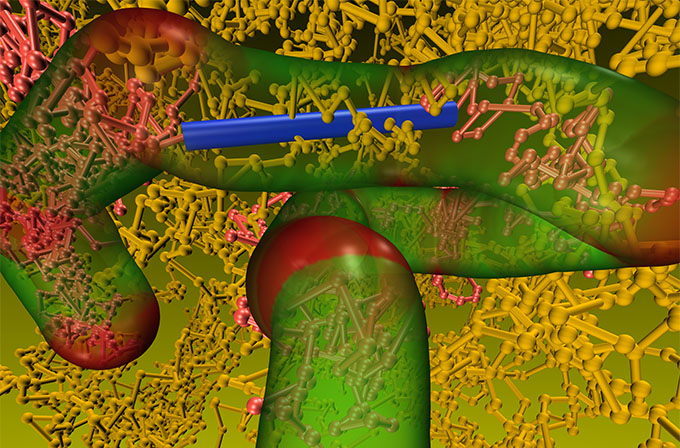![Confined to a tube to approximate the spaghetti-like motion of entangled polymers, a rod–coil block copolymer (rod in blue, coils in pink) moves through a sea of molecules. Flow is impeded when a molecule with a rod passes through a curved portion of the tube (denoted in red). [Image credit: Muzhou “Mitchell” Wang and Christopher N. Lam, Massachusetts Institute of Technology.]](https://insidehpc.com/wp-content/uploads/2015/08/polymer-viz-300x198.jpg)
Confined to a tube to approximate the spaghetti-like motion of entangled polymers, a rod–coil block copolymer (rod in blue, coils in pink) moves through a sea of molecules. Image credit: Muzhou “Mitchell” Wang and Christopher N. Lam, Massachusetts Institute of Technology.]
One of the exciting things about polymers is that their structure can be controlled at the nanoscale, which is necessary for making more efficient organic electronic materials, for harvesting light in photovoltaics, for example,” says Muzhou “Mitchell” Wang, who investigated polymers as a graduate researcher at the Massachusetts Institute of Technology (MIT). “But before we can use these polymers as electronic materials, we need to understand how to effectively process them so that they have the correct structure and properties, and so we need to know about dynamic behavior such as the way their molecules move and how fast [diffusion], and their response to an external deformation [rheology], or how flexible they are.”
Wang and Brad Olsen, project principal investigator and assistant professor in the Department of Chemical Engineering at MIT, in collaboration with Alexei Likhtman, professor of mathematical physics at the University of Reading in the U.K., performed fundamental research on what are called rod–coil block copolymers, polymers with characteristics that make them good study models because not only are they are a class of organic electronics, they also have molecules that are part rigid and part flexible. Polymers similar to these might be used to make electronics that are lighter and more compact, or so flexible they could be rolled up; clothes that have stronger fibers; plastic automotive parts that are lighter and yet very durable; and plastic materials mostly composed of enzymes that could catalyze chemical reactions, explains Olsen.
Compute allocations XSEDE allowed the researchers to use the Kraken (now decommissioned) and Darter supercomputers at NICS, and Gordon at the San Diego Supercomputer Center (SDSC).
The computing time was really critical to this study and several previous papers,” says Olsen. “Without it, we would not have been able to complete any of the studies.”
Source: NICS
Sign up for our insideHPC Newsletter.




